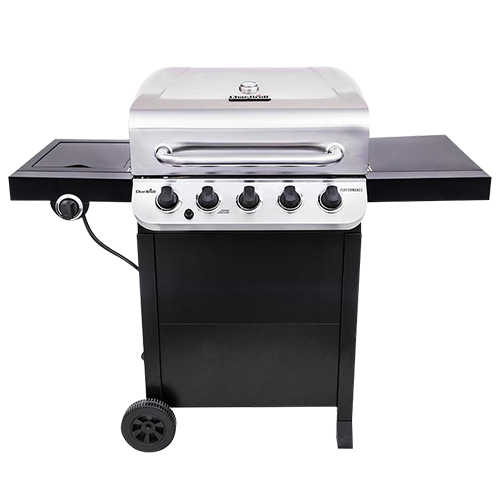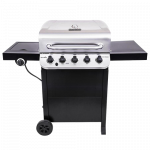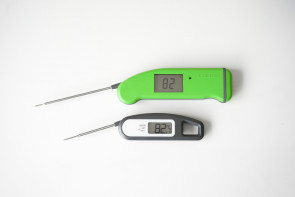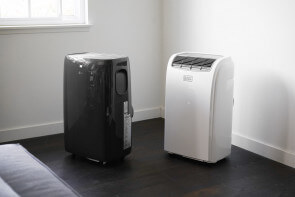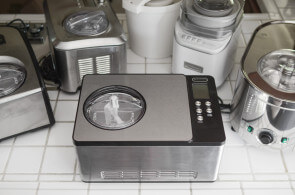
The Best Gas Grills
We tested three top-rated gas grills and chose Char-Broil – Performance as the best gas grill for the price. The five-burner Char-Broil performed identically to the excellent Weber Spirit II – E-310, which is twice as expensive. The Char-Broil gave us perfectly seared and evenly cooked steaks and juicy burgers and chicken. But if you want to upgrade, then the Weber’s superb build quality and impressive ignition and grease-management technology are worth the increased cost.
We tested three top-rated gas grills and chose Char-Broil – Performance as the best gas grill for the price. The five-burner Char-Broil performed identically to the excellent Weber Spirit II – E-310, which is twice as expensive. The Char-Broil gave us perfectly seared and evenly cooked steaks and juicy burgers and chicken. But if you want to upgrade, then the Weber’s superb build quality and impressive ignition and grease-management technology are worth the increased cost.
Table of contents
- Compare the best gas grills
- How we selected gas grills to test
- Assembling a gas grill
- How we tested
- Best value: Char-Broil – Performance
- Upgrade pick: Weber Spirit II – E-310
- Not recommended: Dyna-Glo – DGF493PNP-D
- The bottom line
Compare the best gas grills
| Product | Price | Total Cooking Area (sq. inches) | Heat Evenness | Build Quality | Overall Performance |
|---|---|---|---|---|---|
| Char-Broil - Performance | $$ | 475 | ☆☆☆☆☆ | ☆☆☆☆☆ | ☆☆☆☆☆ |
| Weber Spirit II - E-310 | $$$$ | 529 | ☆☆☆☆ | ☆☆☆☆☆ | ☆☆☆☆☆ |
| Dyna-Glo - DGF493PNP-D | $$ | 597 | ☆☆☆ | ☆☆☆ | ☆☆☆ |
How we selected gas grills to test
Many manufacturers of gas grills frequently update or improve their models, so we looked for gas grills that would not likely be replaced in a couple of years. Although these upgrades are often minor, we focused on grills that manufacturers had released in 2018-2019.
If you have a couple thousand in expendable cash, you could plunk it down on a high-end Napoleon, which has years’-long warranties. A Napoleon, however, may be out of the average consumer’s price range, so we instead we researched the moderately expensive Webers, one of the leaders in the industry.
Weber has several series of gas and charcoal grills — each with a lofty name, like Summit, Genesis and Master-Touch — and we chose to test the Spirit II, since its features are similar to less-expensive brands.
Our tester then personally checked out all of the grills sold at Home Depot and Lowe’s, and since we wanted an equitable test, we selected grills that we believed would be a fair match against the Weber. (For the record, we also considered grills sold at Target, but the selection only included older models.)
To be comparable with the Weber, the grills needed to have at least three burners, two side shelves, approximately the same size cook space (475 square inches) and at least 30,000 BTUs. (If you want to know more about BTUs — British Thermal Units — and their importance, check out our review of the best portable air conditioner.)
Finally, we kept to a budget of no more than $300 each for the other two finalists. Models with cabinets are more expensive, so we chose models that had carts instead. Both the Char-Broil Performance and Dyna-Glo are highly rated by consumers and are available in two to five-burner models. Oddly, Char-Broil’s price decreases with the larger models, and we chose the five-burner for a very reasonable $199 and the comparably priced four-burner Dyna-Glo.
Assembling a gas grill
First off, if there’s an offer (from whichever store you purchased the grill) for free assembly, grab it. Unless you really enjoy building things from nuts and bolts, be forewarned that assembling a gas grill requires two people and two hours of time. Lowe’s sells the Char-Broil fully assembled, so we paid the service charge for its delivery. Amazon usually charges for assembly, but for the Weber, it was free at the time we purchased it. However, since this service might not be available in your location, we decided to assemble the Weber and the Dyna-Glo ourselves to compare difficulty.
The Weber’s shipping weight is 116 pounds, and even with two people, it would be back-breaking to lift and carry the boxed Weber from the driveway to the backyard. So we unpacked and constructed it in the driveway. Although all of the pieces and hardware looked like we were about to put the disassembled Tin Woodsman back together, the Weber’s instructions were detailed and specific. Tools were required (not included), but everything fit perfectly into position.
Assembling the Dyna-Glo was a completely different experience. It weighs less than 65 pounds, because its materials are so much less substantial. The Dyna-Glo’s hood was encased in styrofoam for shipping, but it was dented in several spots. Metal splinters came off its side panels, and its framework was so flimsy, we worried it would not support the grill box. Surprisingly, it held, but the Dyna-Glo’s sturdiness didn’t compare well with the Weber’s.
How we tested
Each grill had an igniter button, and following their manual’s lighting instructions, we preheated the grills to 500°F, which took between 10-15 minutes. We then cooked hamburgers, steak and chicken on each grill in the same way.
Hamburgers

We put four beef hamburgers on each quadrant of the cooking grate to determine whether the grill was hotter in the back, sides or front. We seared the burgers for three minutes, turned them and using a digital meat thermometer, cooked them to medium-rare, between 140°F and 145°F. We let the burgers rest five minutes before cutting into them.
Steak

Next, we heated the grills back up to 500°F (there was always heat loss when the grill hoods were opened) and seared one-inch-thick New York strip steaks (seasoned only with Kosher salt and black pepper) on both sides for three minutes. We then lowered the heat and continued to cook them, turning frequently, until the digital meat thermometer hit 135°F. We took the steaks off the grill and allowed them to rest 10 minutes before cutting into them.
Chicken

We spatchcocked a whole chicken, cut it in half and seasoned each half with Kosher salt and black pepper. Then we turned off two or four burners, depending on how many burners each grill had, and cooked the chicken with indirect heat by putting the chicken on the unlit burners for 30 minutes. When the leg and thigh were cooked through, we transferred the chicken to the lit burner and crisped up the skin until it was golden brown.
Best value: Char-Broil – Performance
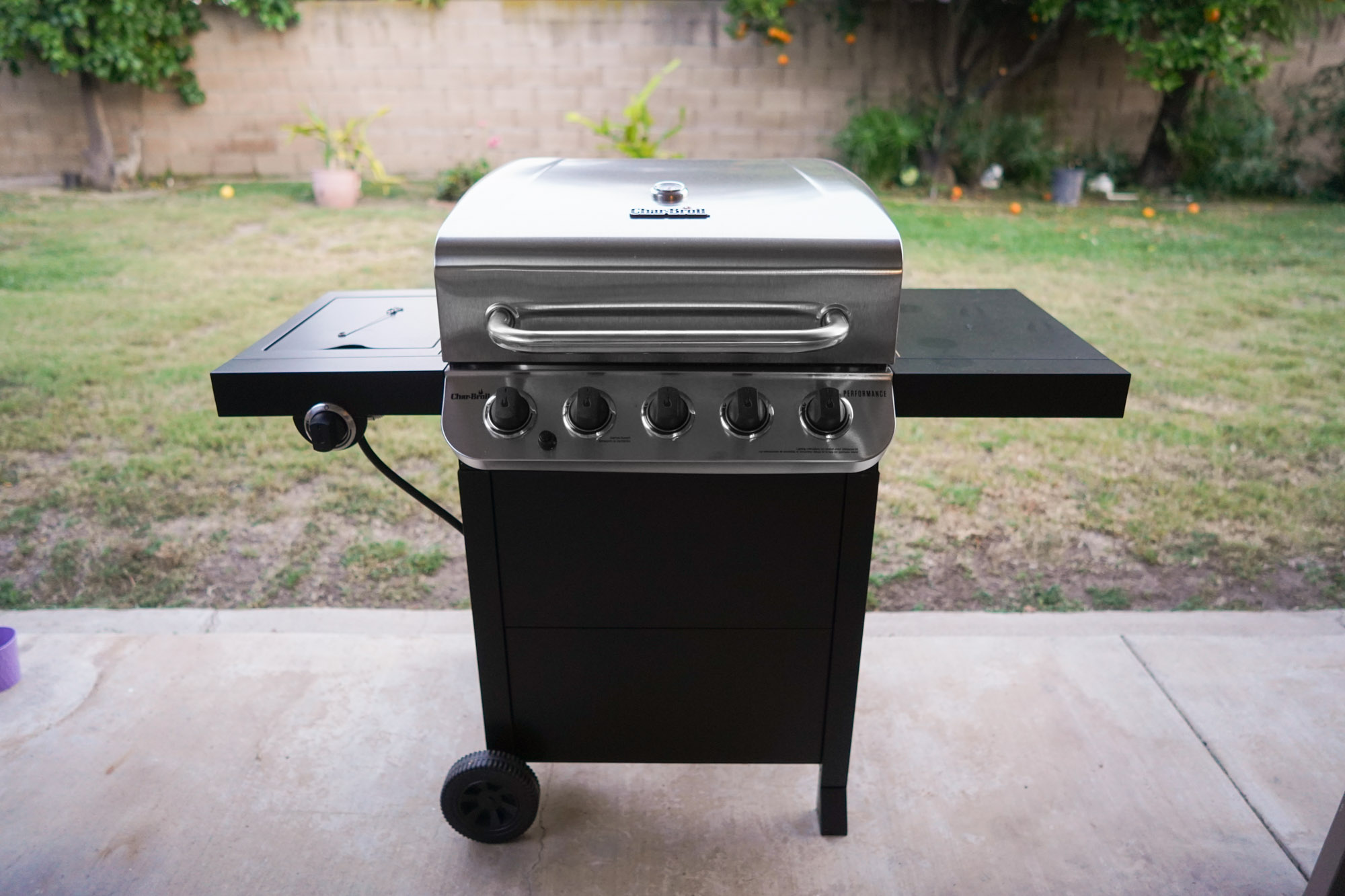
The Char-Broil – Performance – 463347519 five-burner gas grill that we tested had a couple of minor design flaws, but otherwise it grilled everything virtually the same as our upgrade pick, the Weber Spirit II – E-310, and actually bested the Weber in our steak competition with a better sear. At only $199, it’s a fantastic value for this well-made and sturdy grill that we believe will last you several grilling seasons.
Let’s get the design flaws out of the way. Its temperature gauge is located on top of the hood, so we couldn’t easily see the temperature without getting closer and looking directly down at the gauge. Second, the hood has a stainless steel handle that gets searingly hot when grabbed near the curvature close to the lid.
Physically, the Char-Broil has some of the same features as the Weber: porcelain-coated cast-iron cooking grates, recessed porcelain-coated flame tamers — which vaporize grease and force excess grease to drip below — and a tapered drip pan that funnels grease to a small tray underneath the fire box.
The Char-Broil took five minutes longer to heat up than the Weber and Dyna-Glo, but when it hit 500°F, it maintained that temperature and distributed the heat evenly throughout its 475-square-inch cooking space.
If you’re familiar with grilling, then you know it’s vital to monitor how quickly food is cooking and, if necessary, adjust the heat or move food to the upper rack so it doesn’t burn. We didn’t need to do either with the Char-Broil. The heat stayed consistent, and there were no flare-ups or hot spots. It wasn’t quite “set-it-and-forget-it” cooking, but it was definitely stress-free.
The hamburger we placed in the rear of the cooking space cooked a little faster than the burger in the front, but we simply switched them, and they finished at the same time as the burgers on the sides. The indirect-heat method worked very well with the chicken, which was cooked through and juicy. The steak was a wonder: It seared beautifully, and the fat crisped to a delicious golden brown.
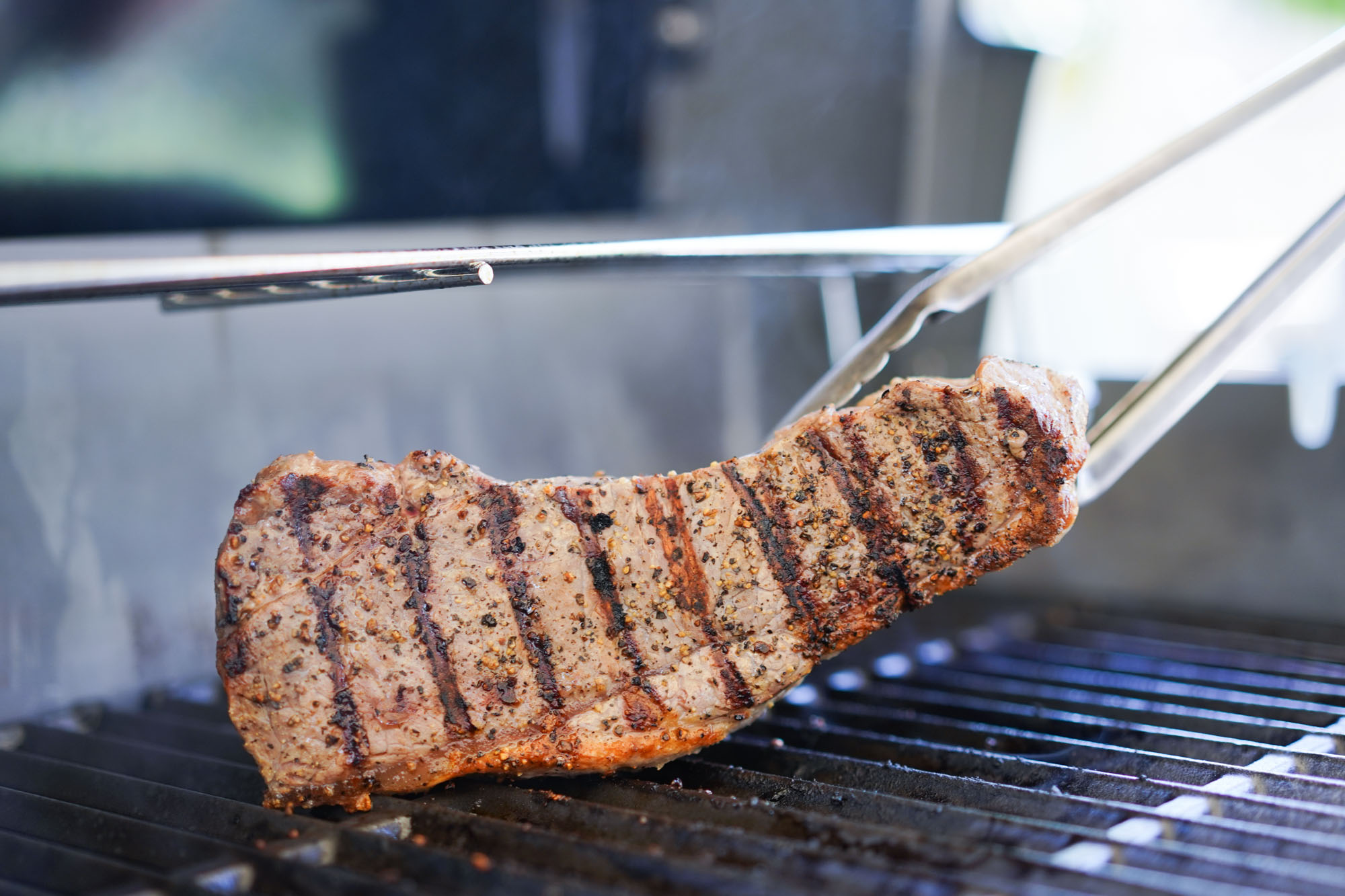
The five-burner Char-Broil also has a side burner with 10,000 BTUs, which can be used for sauteing onions or peppers or making a pan sauce for your grilled meats and vegetables. It measures 53 inches wide and 26 inches deep, so if it’s too large for your patio, the Char-Broil – Performance is also available in several sizes and styles, like a compact two-burner with cabinet, a stainless steel four-burner, cart-style (like the model we tested), and for $400, a six-burner with side burner and a 15,000 BTU sear burner.
If you’re considering buying a Weber, but you can’t justify its high price, the Char-Broil – Performance is an excellent, more affordable option.
Key takeaways:
- The Char-Broil – Performance- 463347519 is a well-made and sturdy propane-gas grill with some of the same features as a comparable Weber, but it’s half the price.
- It maintained and evenly distributed heat over its entire 475-square-inch cooking area during our tests.
- The Char-Broil – Performance seared steak and burgers to perfection and slow-cooked chicken so it had juicy meat and crispy skin.
- A couple of minor design flaws — a misplaced temperature gauge, for one — aren’t deal-breakers.
Upgrade Pick: Weber Spirit II

On grill forums, diehard Weber fans state that any Weber — charcoal or gas — is the best grill money can buy. Other people, however, question why Webers are much more expensive than other grills. We were intrigued as to what made a Weber grill so special.
We selected the moderately expensive Weber Spirit II – E-310 to test, and its performance was excellent, but it did not surpass the Char-Broil. Weber’s build quality, however, can’t be beat, so if you can afford a Weber — and the latest models with infrared are pretty pricey — then we can easily recommend the Weber Spirit II – E-310 as our upgrade pick.
Free assembly was offered when we bought on Amazon, but if it’s not available where you live, or if you really want to get a sense of how well a Weber is constructed, try assembling it yourself. A Weber’s parts and materials are hefty, and even when we had it together, rolling it to the patio was like pushing a wheelbarrow of bricks. Our advice is to build it where it will live.
Weber aggressively markets their patented GS4 technology, consisting of:
- Infinity Ignition, which Weber guarantees will light every time
- Flavorizer bars, similar to Char-Broil’s flame tamers
- Tapered burners, which heat evenly across the entire 529-square-inch cooking space
- Grease-management system, again similar to Char-Broil’s, in which a tapered pan forces the grease to drip into a tray with a replaceable foil inset.
The Spirit also has a unique device that attaches to the propane tank and indicates the level of propane gas inside the tank. The temperature gauge is located on the front of the hood, so it’s easy to see the grill’s internal temperature (when the lid is closed) even from across the patio.
The Spirit heats up fast and maintains the temperature, until the hood is opened to flip or turn the food you’re grilling. Each time we lifted the hood, the grill’s internal temperature dropped 100 degrees. Once the hood was closed again, the grill rapidly reheated.
Built to Last: Weber Spirit II - E310
All Webers are expensive, and the Spirit is no exception. But you’re paying for superb construction and high-end technology that deliver excellent cooking results. If durability, design and performance are what you expect from a grill, then the Weber Spirit II is for you.
There was almost no difference between the Spirit and the Char-Broil in cooking results. We did notice, however, that the Spirit was slightly hotter in the back of the grill and less hot on the left side. We accommodated this discrepancy by shifting food towards the center or far right, when we wanted to sear the steak.
Overall, we were impressed by the Spirit’s design and can understand why Webers have a passionate following. The Spirit — and all Weber models — are built to last in most climates, and anecdotally, its devotees claim their Webers are still going strong after ten years, which is remarkable, considering many grills collapse into rust when exposed to the elements for a year or two.
The Spirit II series is also available in the same price range as a red two-burner, and for $150 more, a sleek and modernistic black three-burner with a cabinet.
Weber’s new Genesis II series is nearly double the price of the Spirit II series for a three-burner grill, but its additional features include a side burner, stainless-steel grates (instead of porcelain-enameled) and Weber’s iGrill 3 smart technology that allows you to monitor the grill’s internal temperature with an app.
For its durability, design and performance, we think the Weber is worth the high price tag.
Key takeaways:
- It’s expensive, but the Weber Spirit II – E310’s build quality and technology make this grill a clear upgrade from other starter models.
- Weber’s advanced GS4 grill system includes an igniter that’s guaranteed to light every time, even heat distribution, grease management to prevent flare-ups and an indicator that shows the level of propane remaining in your tank.
- The Spirit II – E310, like all Webers, is a heavy-duty grill designed to last for decades in most climates.
Dyna-Glo – DGF493PNP-D

The Dyna-Glo – DGF493PNP-D four-burner gas grill is only $20 less than the Char-Broil – Performance, but the difference in build quality and performance was noticeable. The Dyna-Glo is a popular grill sold by Home Depot, but in reading online reviews, it’s clear that people are buying it for a single season and hoping it will last through the winter to maybe get a second summer out of it. That’s a fair assessment; its lightweight and cheaply finished materials would soon rust if the grill was left outside in the rain and snow.
During our testing, we had frequent grease flare-ups, which upon inspection, were caused by the Dyna-Glo’s flame tamers: they’re too narrow and positioned directly under the cooking grate. Consequently grease drips off the cooking food onto the burners rather than the bottom of the firebox. We needed to keep a close watch that the sudden bursts of flame didn’t burn everything we were grilling.
The back of the grill was much hotter than the front, so we continually re-positioned the food to prevent it from overcooking. Overall, grilling on the Dyna-Glo was more hands-on and a less pleasant experience than it was with the Char-Broil and Weber. If you’re looking for an inexpensive grill, we recommend the far superior Char-Broil – Performance instead.
The bottom line
If you’re new to grilling or you’re looking to replace the grill you have, we recommend the Char-Broil – Performance series as the best gas grill for the money. We tested the five-burner, but the Char-Broil Performance is available in other sizes to suit your needs or space requirements.
It’s sturdily made, heats and cooks evenly and makes it easy to grill like a pro,
If you want to upgrade, the Weber Spirit II – E310 lives up to the company’s storied reputation. Like all Weber grills — both charcoal and propane gas — the Spirit is heavy-duty and built to last. Its high-end infinity ignition system, evenly distributed heat and grease management are worth the splurge if you grill everyday.
More Reviews
The 8 Best Electric Egg Cookers
Elite Gourmet - EGC-007B
The 8 Best Salt and Pepper Grinders
Merazi Living
Blue Apron
Martha & Marley Spoon
HelloFresh Meal Delivery Kit Review
HelloFresh
Whynter - ICM-200LS


